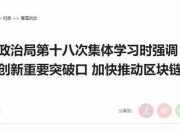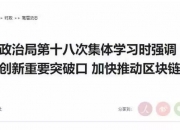7月31日,万向区块链董事长兼总经理肖风在“区块链技术和应用峰会暨第四届中国区块链开发大赛成果发布会”发表了题为《区块链应用落地的三个阶段》的演讲。他表示,区块链应用落地分为发挥存证、溯源等工具性能,重组生产关系,基于区块链的价值分配和价值交换三个阶段。
On 31 July, Huan Xiao Feng, Chairman and Chief Executive Officer of the Block Chain, delivered a presentation entitled "The Three Stages of Block Chain Application Landing" at the launch of the "Technology and Applications of Block Chains Summit and the Fourth China Block Chain Development Competition". He said that the block chain application was divided into three phases of tool performance such as record-keeping, traceability, reorganization of production relations, and was based on the value distribution and value exchange phases of the block chain.

万向区块链董事长兼总经理肖风
肖风表示,在区块链应用落地的1.0阶段,区块链技术主要发挥存证、溯源等工具性能。这一工具性应用可以追溯到六七年年前甚至更早。
Shao Feng states that during phase 1.0 of the block chain application, the block chain technology primarily uses tools such as documentation, traceability, etc.. This tool application dates back six or seven years, or even earlier.
当前,区块链发展阶段主要为应用落地的2.0阶段。在这一阶段中,区块链技术扮演起重组生产关系的角色,催生出基于多边平台的生态关系——分布式商业等创新的商业模式。
At present, the development phase of the block chain is dominated by the application of the fielding phase of 2.0. During this phase, block chain technology plays a role in restructuring productive relationships, generating innovative business models based on eco-relationships in multilateral platforms, such as distributed commerce.
“目前,在工业互联网和物联网等领域,都已经看到了区块链在重构生态关系方面的应用。”肖风说。
“For the time being, the application of block chains in the re-establishment of ecological relations has been seen in areas such as industrial Internet and physical networking.” Shao Feng says.
肖风进一步指出,随着央行数字货币的发行,多边平台越来越活跃,会进入区块链应用落地的3.0阶段,即资产数字化和数字资产化所带来的基于区块链的价值分配和价值交换。
Shao Feng further noted that, with the issuance of central bank digital currencies, the multilateral platform has become more active, entering the 3.0 phase of block chain application, i.e. value distribution and value exchange based on block chains as a result of the digitization of assets and digital assetization.
肖风表示,达到3.0阶段需要一些更加成熟的条件,包括央行发行的合规合法的数字货币,需要智能合约,包括在智能合约领域建立国家标准。
Shaw Fung stated that achieving phase 3.0 would require more mature conditions, including legally compliant digital currencies issued by central banks, and smart contracts, including the establishment of national standards in the area of smart contracts.
附肖风“区块链应用落地的三个阶段”的演讲原文:
很荣幸大会主办方给我在此分享想法的机会,我将紧扣区块链技术和应用的主题,谈谈我对区块链技术应用落地的看法。
It is an honour for the sponsors of the General Assembly to give me the opportunity to share my ideas here, and I will focus on the theme of block chain technology and applications, and share my views on the location of block chain technology applications.
我认为区块链的应用落地可以分成三个阶段。
I believe that the application of the block chain can be divided into three phases.
在区块链应用落地的1.0阶段,区块链技术主要发挥存证、溯源等工具性能。这一工具性应用可以追溯到6、7年前甚至更早,所以我们可以说,区块链应用落地的1.0阶段已经发生很长时间了。
At phase 1.0 of the block chain application, the block chain technology is primarily based on tool performance such as documentation, traceability, etc. This tool application dates back six, seven years, or even earlier, so we can say that phase 1.0 of the block chain application has been in place for a long time.
而今,我们已经迈入区块链应用落地的2.0阶段。在这一阶段中,区块链技术扮演起重组生产关系的角色,催生出分布式商业等创新的商业模式。
Today, we have moved into phase 2.0 of the block chain application. During this phase, block chain technology has played a role in restructuring productive relationships and generating innovative business models such as distributed commerce.
关于商业模式的演变,《平台战略》一书从平台角度将商业组织分成了三类平台:单边平台、双边平台和多边平台。
With regard to the evolution of business models, the Platform's Strategy has divided business organizations into three types of platforms from a platform perspective: unilateral, bilateral and multilateral.
单边平台企业是工业革命早期的产物。这类企业的商业模式是单向的,即通过大规模生产标准化产品降低生产成本,再将标准化的产品卖给尽量多的客户,赚取商业利润。通用汽车就是工业革命时代单边平台企业的典型代表。
Unilateral platform enterprises are the product of the early stages of the industrial revolution. The business model of such enterprises is one-way, i.e. reducing production costs through large-scale production of standardized products and selling them to as many customers as possible for commercial profit.
双边平台则诞生于互联网时代,如优步、滴滴都是基于互联网的双边平台。
Bilateral platforms were born in the Internet era, such as those based on the Internet.
多边平台就是应用区块链技术对双边平台这种商业模式进行创新,即用分布式方法搭建一个更多的参与方都能参与的多边平台,将双边平台中的双向关系升级成一个点对点的,能够完成更多商业活动和交易的网状关系。由此可见,区块链技术可以非常好地创新、重构基于多边平台的生态关系,形成业界常说的分布式商业。目前,我们在工业互联网和物联网等领域,都已经看到了区块链在重构生态关系方面的应用。
The multilateral platform is the application of block chain technology to innovation in a business model such as a bilateral platform, with a distributed approach to building a multilateral platform in which more participants can participate, upgrading the two-way relationship in a bilateral platform to a point-to-point where more commercial activities and transactions can be accomplished. Thus, block chain technology can be very innovative, reconfigured on a multilateral platform-based ecological relationship, and form what industry is often called distributed commerce.
工业互联网这一说法最早是由GE的一位研究人员创造出来的,在美国叫工业互联网,在德国则叫工业4.0。但到目前为止,不管是德国的工业4.0还是美国的工业互联网,都没有取得预期的进展和成果。关键问题在于工业互联网并不只是简单地实现内部生产流程和制造流程的智能化,而是需要打破企业的围墙,打造产业链和供应链网络,这就会涉及众多参与方。
But so far, neither industrial 4.0 in Germany nor industrial Internet in the United States has made the desired progress or results. The key issue is that the industrial Internet does not simply create the intelligence of internal production and manufacturing processes, but rather needs to break the corporate fence and build industrial chains and supply chain networks, which involve a wide range of participants.
另外一个问题,工业互联网应该实现工业制造和工业企业智能化。单个企业的智能化缺乏海量、完备和多维度的数据来支撑AI算法的运行,并从智能化角度来提升企业的制造或者服务水平。因此,单个企业需要汇集自身之外的其它数据源,或者在产业链上与大家共享数据。
Another problem is that the industrial Internet should be intelligent in industrial manufacturing and industrial enterprises. The intellectualization of individual firms lacks big, complete and multi-dimensional data to support the operation of AI algorithms and enhances their manufacturing or service levels from an intelligent perspective.
但是,要实现数据共享,首先就需要相应的技术系统保证数据的可靠性。其次需要相应的技术解决方案保护数据隐私。数据可靠性和数据隐私问题若得不到解决,工业制造业的智能化就会存在非常大的缺陷。任何一个企业都希望有更多数据来源,以训练AI算法。但在数据隐私保护、数据可信、数据安全等问题尚未解决的情况下,现有的技术解决方案都难以帮助企业达成收集更多数据训练AI算法的目标。
But sharing of data requires, first and foremost, corresponding technical systems to ensure data reliability. Second, there is a need for corresponding technical solutions to protect data privacy.
然而我们看到区块链能为解决数据安全、可信和隐私问题提供一个非常低成本的方案。同时,区块链加上隐私计算、密码学等技术又能提供低成本的在商业上可行的数据保护和数据协同计算的方案。当然,现在也有一些保护数据安全和隐私的机制,但这些现有机制在跨企业、跨产业的场景就不一定是可行的商业方案了。现有中心化机制会要求所有企业将数据集中到中心化的数据库中,企业自然会担心隐私数据被泄露。
However, we see that block chains can provide a very low-cost solution to data security, credibility, and privacy issues. At the same time, blocks chains, coupled with technologies such as privacy computing, cryptography, and so on, can provide low-cost commercially feasible data protection and co-production options.
区块链应用落地的2.0阶段,并非区块链应用的最终阶段。接下来,随着央行数字货币的发行,随着多边平台越来越活跃,我们会进入区块链应用落地的3.0阶段——也就是资产数字化和数字资产化,所带来的基于区块链的价值分配和价值交换。在这一阶段中,我们会看到数字化、智能化之后,再进行金融化、资产化,重新带来基于利益相关者的经济体制,新的价值评估、价值分配、价值交换的区块链应用被建立起来。
Next, as central banks issue digital currencies, and as multilateral platforms become more active, we will move to phase 3.0 – the digitalization of assets and the digitalization of assets, with value distribution and value exchange based on block chains. At this stage, we will see digitization and intelligence followed by financialization, assetization, and the re-establishment of a stakeholder-based economic system, with new value assessment, value distribution, and value exchange chain applications in place.
要想达到3.0阶段,还需要一些更加成熟的条件。如在这样一个价值流通的体系里面,我们需要有央行发行的,合规合法的数字货币,需要智能合约,包括刚才赵院长(此处指中国电子技术标准化研究院院长赵波)讲到的,标准化研究院在智能合约领域建立国家标准方面所做的努力。
Some more mature conditions are needed to reach stage 3.0. In such a system of value flows, we need a central bank-issued, legal digital currency, smart contracts, including the efforts of the Institute of Standardization to establish national standards in the area of smart contracts, as stated earlier by President Zhao (in this case, President Zhao Bo of the Chinese Institute for Standardization of Electronic Technology).
通过自动化计价来衡量每个人的价值贡献,用智能合约来分配各自创造的价值。这是一个非常重要的变化。从去年、前年开始,全球资本市场也发生了这样的变化,即从股东资本主义走向利益相关者资本主义。利益相关者不一定有股权关系,甚至不一定认识。就像在公链上,我们也不一定认识,加入网络也不需要得到别人的许可。
This is a very important change. Since last year, there has been a change in global capital markets, from shareholder capitalism to stakeholder capitalism. Stakeholders do not necessarily have equity relationships, or even recognize them.
我相信,区块链应用最后将走到这一步,即在区块链的基础上,诞生非常智能化的经济体。这是我们可以期待的。目前,2.0阶段正在不断完善,任何一个平台、网络或是系统的建设,都可以考虑采用分布式的方法,变成一个开放、开源、共享、共治的分布式经济体。
I believe that the block chain application will end up at this point, where a very intelligent economy is born on the basis of the block chain. This is what we can expect. Currently, phase 2.0 is being refined, and any platform, network or system can be built by considering a distributed approach to an open, open, shared, co-managed distributed economy.
特斯拉对核心技术进行了开源,从最早开源的电池技术,到最近在推特上宣布开源自动驾驶技术。特斯拉的自动驾驶技术被认为是最接近L4级别的自动驾驶,马斯克也愿意开源。他通过数字化重新定义了汽车,同时通过开源核心技术的方式,重新定义什么是数字经济。
Tesla opened up the core technology, from the earliest cell technology to the recent announcement of open-source autopilot technology on Twitter. Tesla’s autopilot technology is considered to be the closest to the L4 level, and Mask is willing to open the source. He redefined the vehicle through digitization, while redefining the digital economy through open-source core technology.
区块链就是数字经济的基础设施,可以构建开放、开源、可扩展性非常灵活,同时没有商业边界的分布式商业。这是区块链技术能够带来的,也是值得大家投入精力共同探讨的:我们如何建立分布式商业合作的关系。
Block chains are the infrastructure of the digital economy that can build open, open-source, scalable, and distributed commerce without commercial boundaries. This is what block chain technologies can bring, and it is worth exploring together: how we can build distributed business partnerships.
谢谢大家。
Thank you.
注册有任何问题请添加 微信:MVIP619 拉你进入群

打开微信扫一扫
添加客服
进入交流群




















发表评论